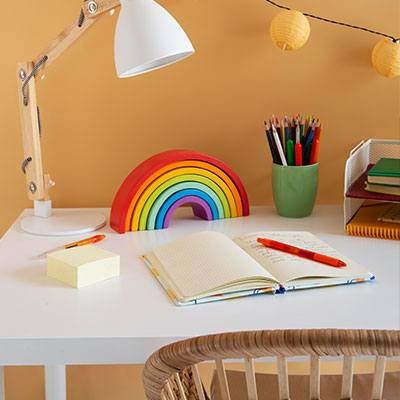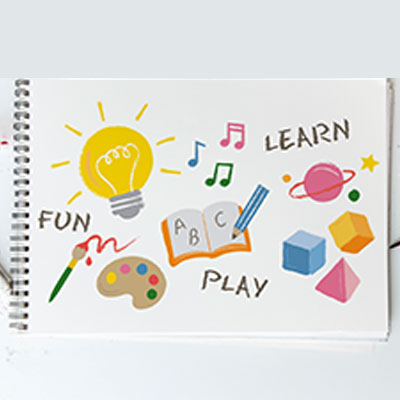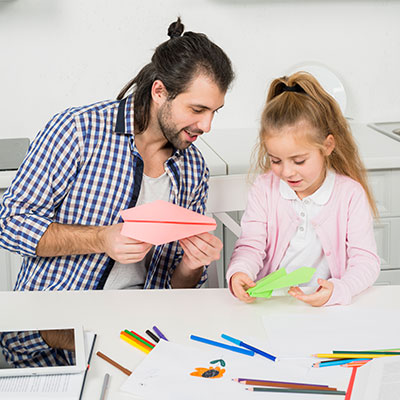Keeping your child focused at home can be challenging. Between online classes, homework, and everyday distractions, kids can quickly lose concentration or feel frustrated.
You don’t need a separate room or expensive furniture to create a study space at home. A corner of a bedroom or living room can be transformed into a study space, which will show positive results. With a little creative thinking, you can create a study space at home that has distractions under control and motivates your child to participate in online learning.
In this blog, we will share some parent-friendly tips that will help you create a study space at home that keeps your child motivated, focused, and happy while learning.
Why Creating a Study Space at Home for Kids Boosts Focus & Learning
A house is where all children feel safe, loved, and comfortable. But in the case of online schooling, parents are wondering if that is sufficient. Of course, your child may have a cozy nook or their special place at the table, but is that room actually allowing them to concentrate, or is it covered with distractions? Distractions at home can impact a child’s learning and, over time, lead to noticeable learning gaps. That is why creating a study space at home matters for your child.
Sometimes, even the coziest corner won’t help if it doesn’t spark focus and learning. Having a study room at home isn’t merely a matter of providing a desk or a quiet place, it’s providing your child with an area that their brain associates with work. When children study in the same space where they play or relax, distractions creep in easily. As a parent, you don’t need to transform your living room into a traditional classroom. All you have to do is create a study space at home, which will give your child a reliable environment for focus and growth.
When the area is cozy and welcoming, studying is no longer a chore but becomes a routine in their life. A reliable study area signals- this is where I learn, I concentrate, and I get things done.
Creating a study space at home makes a huge difference in focus and confidence. Imagine trying to finish an online lesson while siblings run around or the TV is on. Now picture the same lesson in a quiet corner with good lighting, organized supplies, and a few personal touches.
Benefits of Creating a Study Space at Home Are
- Fewer distractions and more focus
- Boosts motivation and independence
- Reduces stress during study time
- Gives children ownership of their space
Even if you don’t have a separate room, you can create a study space at home in places like the living room or bedroom that makes a huge difference. And here’s how you can do it.
1. Select the Right Location

The very first and critical step of creating a study space at home is choosing the right location. The right spot makes all the difference in how well your child studies.
Tips for Finding the Ideal Location
- Quiet and traffic-free- Pick a corner out of the way of the TV, kitchen, or traffic-free hallways. Even a small nook will do wonders.
- Well-lit- Natural light is best, but an excellent desk lamp will do the trick. Bad lighting makes reading a task and reduces concentration.
- Consistency – Whenever possible, utilize the same place every day. Familiarity with a place makes the brain connect the space to study.
2. Personalize the Space

Children are more likely to enjoy and use a study room at home when they feel it belongs to them. It becomes their place, a corner that inspires big dreams, steady focus, and Self-motivation. Personal touches like favorite colors, posters, or small decorations make the space inviting.
It also promotes independence, as they take responsibility for keeping it organized. Ultimately, creating a study space at home turns learning into a more enjoyable and meaningful experience.
Ways to personalize
- Balance fun with focus – Personalization should inspire without creating distractions.
- Highlighting – important lines in textbooks makes essential information stand out. Using bright colors for notes or markers can attract the brain’s attention and improve recall.
3. Organize Essentials

Organization is the secret ingredient to better focus. Think about it, if your child has to pause every few minutes to look for a pencil, charger, or notebook, frustration builds up. Those little interruptions add up, and soon, frustration takes over.
That’s why parents who want to create a study space at home should focus on keeping only essentials within reach and arranging everything neatly.
A messy desk feels overwhelming, while an organized space creates calm and clarity. Even little habits, like putting supplies back in the same spot after each session, can make a big difference. When the study space is organized, your child can dive right into learning instead of wasting energy searching for things.
Tips for an Organized Study Room
- Use small organizers, drawers, or baskets for other materials.
- Guide your child to tidy up at the end of each session.
4. Don’t Get Too Comfortable

Comfort is important, but too much comfort can reduce focus. According to the American College of Healthcare Science, studying or learning in bed can affect sleep patterns, limit focus, and decrease productivity.
Adding interactive tools like sticky notes and chart paper on the wall can help write down difficult concepts or points they need to remember, and engage the brain actively. When they write, their brain unconsciously starts to memorize the information, making recall easier later.
Focus on comfort
- Chair and desk – Ensure proper back support and correct desk height.
- Lighting – Good lighting prevents eye strain and fatigue.
- Temperature – Avoid overly hot or cold spots.
5. Use Technology for Learning

Technology can be a powerful tool for online learning, but it can also become a major distraction if not managed carefully. Some parents, relying on phones to keep their child occupied, may hand over devices to get a moment of peace, unintentionally encouraging distractions instead of focused learning.
Tips for Smart Technology Use
- Use apps and tools that support learning, online quizzes, reading platforms, or math games.
- Set clear rules for social media, games, or unnecessary browsing should be avoided during study time.
- Use timers or focus apps to help your child stay on track.
6. Minimize Distractions

Even if you carefully create a study space at home, distractions can still sneak in. Imagine this, your child trying to focus on homework while the TV noise, siblings, or street sounds keep breaking their attention. APA PsycNet says students paid less attention and performed worse when they tried to multitask or use their phones while doing other activities like learning, walking, or working. When their focus keeps shifting, studying becomes frustrating and less productive, even in a quiet-looking space.
Ways to Reduce Distractions
- Keep phones away or on “Do Not Disturb” mode.
- Turn off unrelated devices, like the TV or music players.
- Consider noise-canceling headphones if your child is sensitive to sounds.
7. Promote healthy Breaks

As a parent, you shouldn’t expect your child to sit and study all day without breaks they need short pauses to recharge. Instead of saying, “No playing until you finish everything” or “You can eat only after your work is done,” try something like -“Let’s finish this chapter, then you can grab a snack and stretch before starting the next one.” This makes study time feel less like a punishment and more like a balanced routine. And remember, every child’s brain works differently, so the length of breaks can be different.
Break Ideas
- 5–10 minute breaks every 45–50 minutes
- Water bottle nearby and healthy snacks
- Stretching, a short walk, or a quick doodle session.
8. Flexibility Matters

What works for your child today might not work a few months from now. Children grow, their learning needs change, and their attention spans shift. A study space that was perfect for elementary school may feel cramped or boring in middle school.
A schedule that worked before may need adjusting as classes and homework increase. Ask your child to share what’s working and what isn’t. Sometimes they may need a quieter corner, other times, a more colorful or interactive space helps.
Flexibility teaches them it’s okay to adapt and find what truly helps them concentrate. It also teaches valuable life skills, like adaptability and self-awareness. The goal is to create a study space at home that helps your child, keeping learning effective and enjoyable.
Tips
- Younger children may need brighter, playful setups.
- Older students may prefer quiet, minimalist spaces.
- Rearrange furniture or add new supplies as needed.
9. Encourage Responsibility

Children feel more motivated when they take responsibility. Let them create a study space at home. It helps them take learning seriously because they feel ownership of the space. They start understanding the connection between effort and results in a practical way. It also reduces conflicts over messy desks or missing supplies.
How to Foster Responsibility
- Let your child decide where items go on their desk.
- Promote weekly tidying routines
- Praise them for keeping their space clean and functional.
10. Create Positive Study Habits

As a parent, your habits have a big impact on your child. When they see you making time for your hobbies, they learn that it’s important to do things that make you happy. It could be reading a book, cooking a new recipe, painting, or any activity you enjoy.
The key is consistency, doing these things in front of them shows that self-care and personal growth matter. Children learn more from what they see than what they’re told. Seeing you focused and enjoying your hobbies inspires them to explore their own interests. It also shows them that balancing responsibilities and fun is possible.
Even small daily habits, like journaling or practicing an instrument, can inspire them. Your efforts show that learning and personal development happen in everyday life. What you do in front of them shapes how they approach their own growth and happiness.
Tips for Parents
- As a parent, you can also create a study space at home for your own work or study. When your child sees you using it, they’ll think, “If my parents focus on their space, I should do the same in mine.”
- Show focus and organization during study hours
- Avoid distractions like constant phone-checking while nearby
Extra Tips for Parents
Visual schedule- Post a simple timetable for study and breaks.
Motivational cues- Stickers, charts, or small rewards celebrate effort and consistency.
Regular review- Check the study space every few months to ensure it meets your child’s evolving needs.
We know as parents you are planning to give your child a better future, and that’s wonderful. But it’s important to remember that they’re still children. They shouldn’t feel so burdened by studies that they miss out on a normal or a happy childhood. Teach them to learn and work hard, but also help them keep balance so learning never turns into frustration.
Final Reflection
Creating a study space at home is about more than setting up a desk and chair it’s about giving your child a place where focus, motivation, and independence can grow, while still keeping the warmth of home. When you create a study space at home, you’re building a foundation for better learning habits, reduced stress, and more independence.
A simple, comfortable corner free from distractions can be just a study space at home. Add a touch of personalization, keep the essentials organized, and use technology thoughtfully to support learning, not overwhelm it.
Cyboard school isn’t just about student success, it’s about understanding the bigger picture. Parents can talk to our teachers anytime about their child’s challenges, because supporting both parent and student is at the heart of what Cyboard School does.


